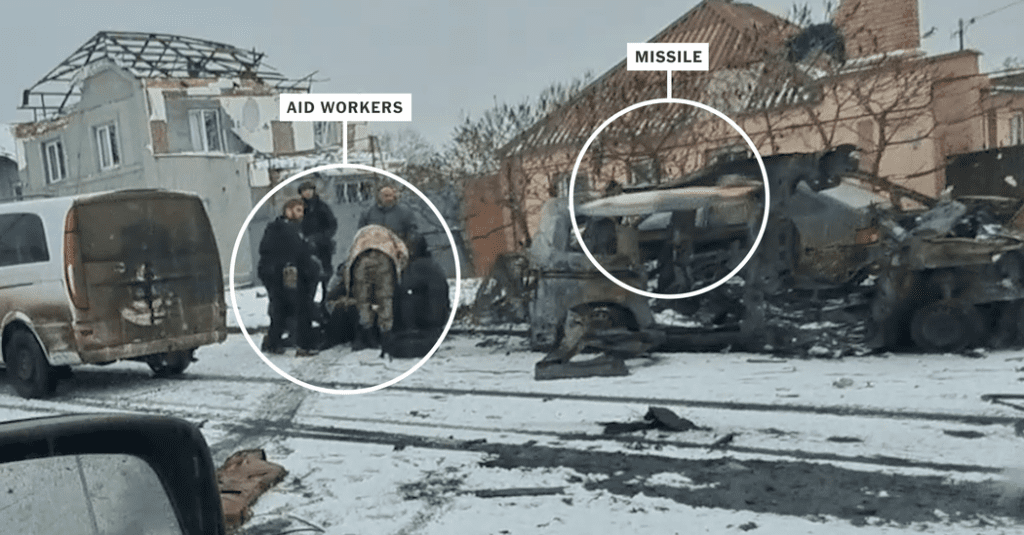Roughly a minute after an American paramedic, Pete Reed, and a team of aid workers began tending to a wounded civilian in the Ukrainian city of Bakhmut on Feb. 2, they were attacked. Mr. Reed, a former U.S. Marine volunteering on the war’s front lines, was killed, and several of his colleagues were wounded.
Volunteers at the scene initially attributed the strike to indiscriminate Russian shelling. But a frame-by-frame analysis of a video taken at the location — and shared with The New York Times — shows that Mr. Reed, who was unarmed, died in a targeted strike by a guided missile almost certainly fired by Russian troops.
It is unclear if the Russians knew the group was made up of aid workers. But its convoy had markings that should have signaled to the Russians the type of vehicles they were hitting. One of the vehicles was clearly marked with a red cross, and the type of weapon used in the attack — a laser-guided antitank missile — is usually fired when a gunman sees and selects a target.
Still, the target in this case, a white Mercedes-Benz van, did not have any clearly visible medical markings, and while the aid workers were unarmed at least one medic was wearing military-style camouflage.
The video shows Mr. Reed and the group of aid workers standing beside the white van, which they were using to transport humanitarian supplies. A missile flying parallel to the ground directly hits the van, destroying it and killing Mr. Reed.
The video was filmed on a smartphone by Erko Laidinen, an Estonian volunteer with an organization called Frontline Medics who was trailing just behind Mr. Reed.
The footage appears to show that the strike involved a Kornet antitank guided missile, which has a range of around three miles. Mr. Reed and the aid workers were at a slightly elevated position along a street that led toward the Russian front line, around two miles away.
Mr. Laidinen said that his vehicle’s dash camera had also recorded the episode, and that the footage showed a second missile strike, which was aimed at another vehicle but missed its target. The footage has yet to be made public.
How The Times uses visuals to investigate the news. Our Visual Investigations team is made up of more than a dozen journalists who combine digital sleuthing and forensic analysis with traditional reporting to deconstruct news events. They have uncovered important details about drone strikes, police shootings and the Capitol riot.
A volunteer named Roma, who was standing near Mr. Reed when the missile struck and who was wounded in the blast, told The Times in an interview that there had been no military units nearby. One of the vehicles at the scene was clearly marked as an ambulance, he said.
He provided only his given name because of safety concerns.
A photograph published by The Wall Street Journal shows an injured Norwegian medic running from the scene of the attack. It also shows the ambulance marked with a red cross on a white background across the street from where Mr. Reed and other volunteers were attacked.
Experts said the type of weapon used should have enabled the attacker to identify the nature of the target. With weapons such as these, “you have an expectation that the firer is going to have the ability to differentiate between a medical worker and a combatant,” said Marc Garlasco, a war crimes investigator who is in Poland training Ukrainian teams investigating war crimes.
Mr. Garlasco added that the episode required further investigation, but that on its face it was a “potential war crime.”
A video of the aftermath shows the aid workers’ white van destroyed by the attack. Debris is strewn around the area, and a body is lying lifeless on the ground.
Bakhmut, an industrial city surrounded by salt mines with a prewar population of around 70,000 people, has been under intense bombardment since the summer. In recent weeks, Russian troops have come increasingly close to encircling the city.
With a small population of civilians still present in the city, aid workers like Mr. Reed and his teammates have served as lifelines for people sheltering in basements without heat and with dwindling rations. On Monday, the Ukrainian military said it would no longer allow aid groups into the city.
Mr. Reed and his team were alerted to the wounded civilian by Ukrainian troops that had just returned from the area. The street had been under shelling or missile attack at some point: At least one other vehicle had been destroyed in the same area, though it was unclear when, Roma said.
Ukrainian forces traverse the battlefield in all types of civilian vehicles, including privately owned sedans and school buses. It is therefore possible that Mr. Reed was targeted because his team had simply driven into a kill zone frequently targeted by Russian troops.
Reporting was contributed by Natalia Yermak in Kyiv, Christiaan Triebert in New York and John Ismay in Washington D.C. Videos and images produced by Axel Boada.

